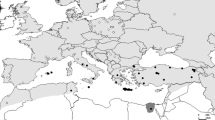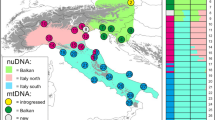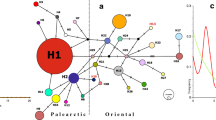Abstract
Black-tailed (Limosa limosa) and Hudsonian Godwits (L. haemastica) are sometimes described as a superspecies. The Black-tailed Godwit is further split into three subspecies on the basis of morphological differences (L. l. limosa, L. l. islandica and L. l. melanuroides). We studied variation in partial mtDNA control region sequences among Black-tailed and Hudsonian Godwits which showed 5% divergence. Black-tailed and Hudsonian Godwits were thus clearly differentiated and the separate species status for the two taxa is validated. All three subspecies described for the Black-tailed Godwit had unique haplotypes but the genetic distances were small (0.3–0.6%). Despite small genetic differences we could not detect any substantial gene flow between any of the subspecies as haplotypes were private to each subspecies. Thus, genetic variation within Black-tailed Godwits showed a clear geographic structure. We found a high proportion of rare private haplotypes in three fringe populations of the nominate subspecies of the Black-tailed Godwit (L. l. limosa) where godwits breed in low numbers, but no genetic variation at all in a sample from the Netherlands where godwits are abundant. This suggests that Dutch Godwits may have been affected by a founder effect.



Similar content being viewed by others
References
Avise JC, Arnold MREB, Bermingham E, Lamb T, Neigel JE, Reeb CA, Saunders NC (1997) Intraspecific phylogeography: the mitochondrial DNA as a bridge between population genetics and systematics. Annu Rev Ecol Syst 18:489–522
Avise JC (2000) Phylogeography—the history and formation of species. Harvard University Press, Cambridge
Baker AJ, Marshall HD (1997) Mitochondrial control region sequences as tools for understanding evolution. In: Mindell DP (ed) Avian molecular evolution and systematics. Academic Press, London
Baker AJ, Piersma T, Rosenmeier L (1994) Unraveling the intraspecific phylogeography of knots (Calidris canutus) - a progress report on the search for genetic markers. J Ornithol 135:599–608
Beerli P (1997) Migrate 0.7. Department of Genetics, University of Washington
Bijlsma RG, Hustings F, Camphuysen CJ (2001) Algemene en schaarse vogels van Nederland (Avifauna van Nederland 2). GMB/KNNV, Haarlem
Brown GG, Gadaleta G, Pepe G, Saccone C, Sbisa E (1986) Structural conservation and variation in the D-loop containing region of the vertebrate mitochondrial DNA. J Mol Biol 192:503–511
Clayton DR (1992) Transcription and replication of animal mitochondrial DNAs. In: Wolstenholme DR, Jeon KW (eds) Mitochondrial genomes international review of cytology/a survey of cell biology, vol 141, pp 217–232
Cramp S, Simmons KEL (1982) The birds of the Western Palearctic, vol 2. Oxford University Press, Oxford
Crandall KA, Binida-Edomnds ORP, Mace GM, Wayne RK (2000) Considering evolutionary processes in conservation biology: an alternative to ‘evolutionary significant units’. Trends Ecol Evol 15:290–295
Douzery E, Randi E (1997) The mitochondrial control region of Cervidae: evolutionary patterns and phylogenetic content. Mol Biol Evol 14:1154–1166
Engelmoer M, Roselaar CS (1998) Black-tailed godwit (Limosa limosa). In: Engelmoer M, Roselaar CS (eds) Geographical variation in waders. Kluwer, Dordrecht
Excoffier L (1993) MINSPNET. Genetics and Biometry Laboratory, Department of Anthropology, University of Geneva
Felsenstein J (1984) Distance methods for inferring phylogenies: a justification. Evolution 38:16–24
Groen NM, Yurlov AK (1999) Body dimensions and mass of breeding and hatched black-tailed godwits (Limosa l. limosa): a comparison of between a West Siberian and a Dutch population. J Ornithol 140:73–79
Hale WG (1980) Waders. Collins, London
Hasegawa M, Kishino H, Yano T (1985) Dating the human-ape split by a molecular clock of mitochondrial DNA. J Mol Evol 22:160–174
Holder K, Montgomerie R, Friesen VL (1999) A test of the glacial refugium hypothesis using patterns of mitochondrial and nuclear DNA sequence variation in rock ptarmigan (Lagopus mutus). Evolution 53:1936–1950
Kruk M (1993) Meadow bird conservation on commercial dairy farms in the western peat district of the Netherlands: possibilities and limitations. PhD thesis, University of Leiden
Marthinsen G, Wennerberg L, Lifjeld J (2007) Phylogeography and supsecies taxonomy of Dunlins (Calidris alpina) in western Palearctic analyzed by DNA microsatellites and AFLP markers. Biol J Linn Soc 92:713–726
Newton I (2003) The speciation and biogeography of birds. Academic Press, Amsterdam
Ottvall R, Höglund J, Bensch S, Larsson K (2005) Population differentiation in the redshank (Tringa totanus) as revealed by mitochondria DNA and amplified fragmenth length polymorphism markers. Conserv Genet 6:321–331
Rambaut A (1996) SeAl sequence alignment editor 1.0. Department of Zoology, University of Oxford
Randi E, Lucchini V (1998) Organization and evolution of the mitochondrial DNA control region in the avian genus Alectoris. J Mol Evol 47:449–462
Rosenius P (1908) Skydd åt rödspofven!. Fauna Flora 3:298–300
Saccone C, Attimonelli M, Sbisa E (1987) Structural elements highly preserved during evolution of the D-loop-containing region in vertebrate mitochondrial DNA. J Mol Evol 26:205–211
Saccone C, Pesole G, Sbisa E (1991) The main regulatory region of mammalian mitochondrial DNA: structure-function model and evolutionary pattern. J Mol Evol 33:83–91
Sambrock J, Fritsch EF, Maniatis T (1989) Molecular cloning: a laboratory manual, 2nd edn. Cold Spring Laboratory Press, New York
Sbisa E, Tanzariello F, Reyes A, Pesole G, Saccone C (1997) Mammalian mitochondrial D-loop region structural analysis: identification of new conserved sequences and their functional and evolutionary implications. Gene 205:125–140
Schneider S, Kueffer J, Roessli D, Excoffier L (1997) ARLEQUIN, version 1.1: a software for population genetic data analysis. Genetics and Biometry Laboratory, University of Geneva, Switzerland
Shadel GS, Clayton DA (1997) Mitochondrial DNA maintenance in vertebrates. Annu Rev Biochem 66:409–435
ON SOV (2002) Atlas van de Nederlandse broedvogels 1998–2000. Nationaal Natuurhistorisch Museum Naturalis, Leiden
Swofford DL (1998) PAUP*. Phylogenetic analyses using parsimony (*and other methods). Version 4. Sinauer, Sunderland
Tajima F, Nei M (1984) Estimation of evolutionary distance between nucleotide sequences. Mol Biol Evol 1:269–285
Teunissen W, Soldaat L (2004) Recente aantalsontwikkeling van weidevogels in Nederland. Levende Nat 107:70–74
Wenink PW, Baker AJ, Tilanus MGJ (1994) Mitochondrial control-region sequences in two shorebird species, the turnstone and the dunlin, and their utility in population genetic studies. Mol Biol Evol 11:22–31
Wenink PW, Baker AJ, Rösner HU, Tilanus MGJ (1996) Global mitochondrial DNA phylogeography of holarctic breeding dunlins (Calidris alpina). Evolution 50:318–330
Wolstenholme DR (1992) Animal mitochondrial DNA: structure and evolution. In: Wolstenholme DR, Jeon KW (eds) Mitochondrial genomes (international review of cytology/a survey of cell biology, vol 141, pp 173–216
Acknowledgments
We thank E. Potapov, E. Strelnikov, I. Fefelov, V. Khrokov, A. Yurlov and P. Tomkovich who helped us to obtain samples from the former USSR. G. Flyckt and C. Cederoth collected samples in Sweden, L. van de Bergh in the Netherlands, G. Gerritsen and N. Groen collected samples on Iceland and J. van Gils in Canada. Collection of material complied with the legislation in the respective country. G. Segelbacher and the late H. Tegelström commented on several manuscripts and discussed the interpretations of the data. The study was supported by the Swedish NFR (grant to J.H.) and the Royal Swedish Academy of Sciences (grant to T.J.).
Author information
Authors and Affiliations
Corresponding author
Additional information
Communicated by M. Wink.
Rights and permissions
About this article
Cite this article
Höglund, J., Johansson, T., Beintema, A. et al. Phylogeography of the Black-tailed Godwit Limosa limosa: substructuring revealed by mtDNA control region sequences. J Ornithol 150, 45–53 (2009). https://doi.org/10.1007/s10336-008-0316-8
Received:
Revised:
Accepted:
Published:
Issue Date:
DOI: https://doi.org/10.1007/s10336-008-0316-8




